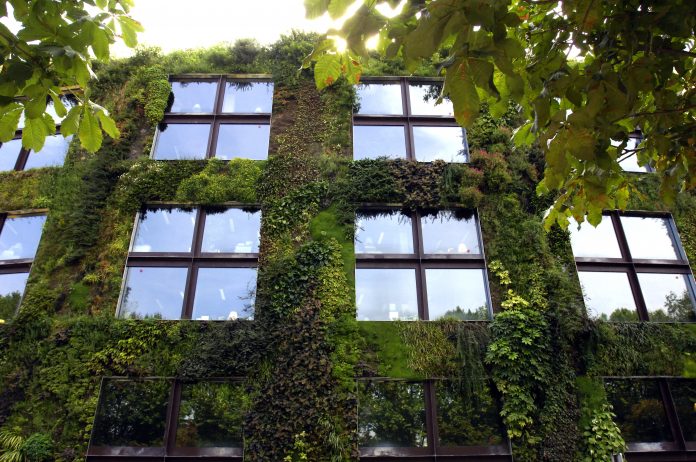Rory Doak, business development manager for Stora Enso, explores how biophilic design can transform dull city centres into thriving major cities
When reading the words ‘concrete jungle’, chances are you pictured a plethora of tall, bleak and unwelcoming buildings made from steel and cement– in other words, lifeless grey and nothing like an actual jungle, full of life, colour and greenery.
Many of the world’s major cities are described as concrete jungles but could things be different?
After months of lockdown, the nation seems to have found a resounding appreciation for nature and green spaces with 47% of adults spending more time outdoors than before Covid-19. It goes without saying that nature offers a number of benefits to our health and wellbeing – as well as the environment.
But for the millions living in our city centres with no garden to bask in or local nature trail to walk, the need to introduce more life into our buildings and urban environments has never been more evident – this is the essence of biophilic design.
Here in the UK, our capital city was named as the world’s first National Park City in 2019, with the aim of making the city greener, healthier and wilder. Part of that is adding more natural outside spaces, but it also applies to using natural materials in the built environment.
Bringing life to the city doesn’t just mean planting more trees but incorporating natural and renewable materials – like wood – into the fabric of it, too.
The essence of biophilic design
What is biophilic design exactly? It is both a radically new approach and an ancient one. Broadly, we can talk about three categories of biophilic design.
The first is “natural analogues” bringing nature into the human environment through non-living or indirect evocations of nature, replicating patterns seen in nature, such as leaves or waves. “Nature of the space” then refers to spatial configurations we are attracted to in nature e.g. spacious, uninterrupted views, or places of refuge where we naturally feel safe. Finally, “nature in the space” and concerns bringing the natural world into our built environments.
This means for example having visual wood in the room, wood to touch, and also trees planted in open atriums etc. It also includes making the natural light flow into the room and doing what is possible to bring nature closer to our daily environments.
Not just a pretty space
Intuitively we can understand that biophilic design can be appealing, but it also boasts a wide range of more tangible benefits for various types of buildings.
In hospitals, biophilic design has been shown to reduce stress, pain and blood pressure while accelerating recovery times. In other settings, it has been shown to boost mood, productivity, creativity and concentration, among other mental attributes.
With modern life conducted up to 90% indoors for many, these are non-trivial benefits that stand to make major differences to bottom-lines and quality of life, as well as strengthening our connection to the natural world.
Why wood?
All three categories of biophilic design are valuable, bringing health, wellbeing and productivity benefits – as well as beauty to our built environments. There is no zero-sum game here and doing lots of one thing doesn’t mean doing less of another. By all means, let’s do it all!
However, as Stephen Richardson, director for Europe at the World Green Building Council commented on a recent podcast: “It’s also about the environmental impacts of those materials, we’re not just thinking about health and wellbeing, and we need to choose materials that are contributing to climate change positively.”
This is why wood – specifically engineered timber – deserves to occupy a special place in our biophilic hearts. Not only does extensive, visible inclusion of wood evoke nature and create all the benefits of biophilic design, it is a potentially carbon negative material. When a tree grows, it captures carbon dioxide from the air.
This is then locked away in the harvested building material for the lifespan of the structure – which could be decades or centuries. In the meantime, new trees (in sustainably managed forests) have continued removing carbon.
What’s more, modern engineered timber materials such as cross-laminated timber (CLT) and laminated veneer lumber (LVL) are strong and durable enough to play the structural role usually automatically assigned to steel and concrete in building design – even in relatively large, high-rise buildings.
In short, engineered timber both evokes, incorporates and protects nature in one swoop – an exemplary form of biophilic design.
Goodbye concrete jungle, hello urban jungle
The need to incorporate nature into our urban environments has never been more apparent. As we look to a post-Covid future with increased importance on health and well-being – and as the UK circles in on its net-zero targets – there has never been a better time to consider all the benefits that biophilic design has to offer.
Let’s surround ourselves with life and build our habitats using materials like wood that evoke the renewable world. There are very real human and environmental benefits to doing so. And who knows – maybe our cities will soon bear more likeness to an actual jungle.

Rory Doak
Business development manager (UK & Ireland)














